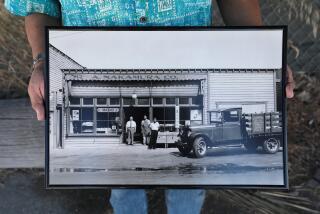Square Mile of Reminder
- Share via
Manzanar, a square-mile plot at the base of the eastern Sierra where as many as 10,000 Japanese Americans were interned during World War II, takes on renewed meaning after Sept. 11. It is a reminder of what can happen to constitutional rights and freedoms even in America. It is equally a tribute to the loyalty of the internees, most of them American citizens. Many an interned family’s son enlisted to fight for the United States.
It is good news, then, that work will at last begin on a memorial and visitor center at Manzanar. It’s been a decade since Congress established the national historic site.
The government built Manzanar in 1942, when post-Pearl Harbor fears ran high. It sits between the towns of Lone Pine and Independence, in the Owens Valley some 200 miles north of Los Angeles. The starkly beautiful setting at the foot of 14,384-foot Mt. Williamson is bleak, hard ground, burned by a harsh sun in summer and freezing winds in winter.
When the camp was closed in 1946, nearly all the buildings were sold off. The only sizable remaining structure is the old auditorium, which was used for years by Inyo County road maintenance crews. The auditorium will be rebuilt and restored to be the visitor center and National Park Service offices. As The Times’ Bettina Boxall reported Monday, construction is scheduled to begin in the spring and the center to open sometime in 2003.
The Park Service plans to reconstruct the eight guard towers that surrounded the barbed-wire enclosure. A call has gone out for any surviving buildings among those that were carted away so many years ago. Inyo County will return a structure that was a mess hall and a county hospital. The Park Service hopes eventually to re-create a block of barracks.
Memorializing Manzanar has been controversial. Some Inyo County residents insisted that the internees deserved to be confined and that conditions were not all that harsh. Former internees, on the other hand, believe Manzanar should be referred to as a “concentration camp.” The Park Service is settling for the blander “war location center.” Because of the local opposition, and the Los Angeles Department of Water and Power’s unfounded fear that it would lose some water rights, the project had languished.
Once built, the historic site will help Americans better understand a dark chapter in their history. A spokeswoman for former internees says they are anxious to see the work done before they die. The nation owes them that.
More to Read
Sign up for Essential California
The most important California stories and recommendations in your inbox every morning.
You may occasionally receive promotional content from the Los Angeles Times.










